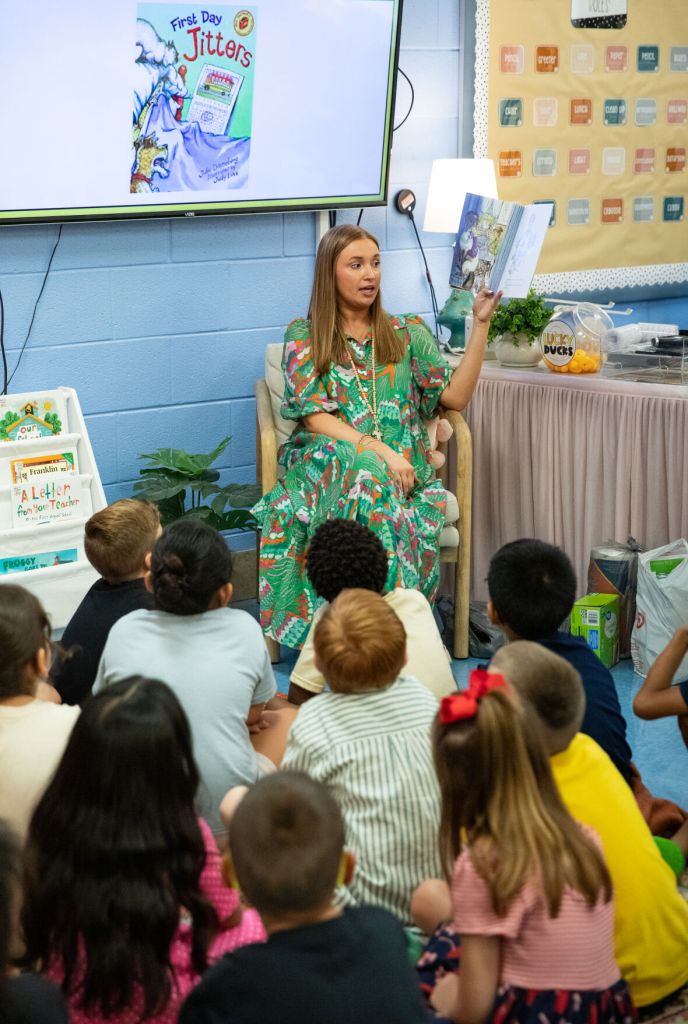Educating Kentucky: Is there still a teacher shortage?
Published 1:30 pm Thursday, August 15, 2024

- Plano Elementary second grader teacher Grace Champion reads “First Day Jitters” by Julie Danneberg to her students on their first day of the 2024-25 school year on Wednesday, Aug. 7, 2024. (Grace Ramey McDowell, Bowling Green Daily News)
By Sarah Michels, Bowling Green Daily News
This is the fourth installment of the Daily News’ Educating Kentucky series examining five major issues Kentucky students and schools are facing. Some sources are unnamed to protect their anonymity when speaking about sometimes-contentious issues.
Students of one central Kentucky school district often find their assistant superintendent at the wheel of a school bus in the mornings and afternoons.
Faced with a busing shortage, the assistant superintendent took it upon himself to help fill the gap, while juggling his other job responsibilities.
While Kentucky’s largest school district, Jefferson County Public Schools, has gotten attention – and criticism – for its busing issues, its dilemma is not unique. Many school districts across the commonwealth are experiencing similar bus driver shortages, as well as employees in other areas.
Since COVID, many sectors of the economy have felt a critical workforce shortage. Education is one.
But how bad is the teacher shortage, really? Has it been overblown or is it just as critical as headlines suggest? The Daily News spoke to over a dozen school leaders to find out.
‘Famine is coming’
While most school leaders said they aren’t experiencing teacher and classified employee shortages in mass numbers, they are noting a diminished applicant pool, in both size and quality.
Daviess County Superintendent Matt Robbins said the past three or four years have been a “hardening of markets” for applications.
He knew to expect this; universities were telling districts that fewer students were entering teacher education programs.
“They were telling us, famine is coming,” Robbins said.
A central Kentucky superintendent said that before COVID, an elementary teacher posting would have 20 applicants. Now, it has maybe two to five. Some positions are even less popular, like certified physical education teachers and educators in STEM areas, he said.
“Trying to find a high school math teacher is like looking for a rainbow unicorn,” the superintendent said.
People who pursue STEM degrees have many options, most higher-paying than a public school math or science teacher, several superintendents commented. Incentives and pensions only go so far.
Some districts are still experiencing a broader shortage. One central Kentucky superintendent said her district lost several teachers this year, and substitute shortages are a near-daily occurrence.
“Some of them moved out of state down South for more wages,” she said. “Some of them just moved out of public education into the corporate world to make more money.”
She added that student behavior after COVID, recovering from pandemic learning loss and an increase in chronic absenteeism have made educators’ jobs harder.
“Besides us competing with business and industries on salaries and wages, we are also dealing with some other things that we’ve traditionally haven’t dealt with since I’ve been in public education for 31 years.”
What the state has done
In recent years, the Kentucky legislature has tackled the teacher shortage in several ways, said Sen. Matthew Deneen, R-Elizabethtown.
One, they’ve expanded alternative pathways to teacher certification, like highly popular Option 6, which allows those without education degrees who have bachelor’s degrees in a content area to teach while pursing their Masters in Education.
Two, the General Assembly has provided student teaching stipends and funded teacher scholarship programs.
Three, the legislature increased transportation funding in this year’s budget in light of bus driver shortages.
Deneen said they now have to collect data on the efficacy of these programs to determine where to go next.
“We will follow the data,” he said.
Culture, rhetoric and pay: other potential solutions
One northcentral Kentucky superintendent said it’s the state’s responsibility to give public schools enough resources to attract teachers with competitive baseline pay, and districts’ job to retain them.
Since he took over his district, it’s seen significant improvement in its working conditions survey. He credits it to positive culture building, which requires employees feeling cared for, having a trusted peer and feeling like a valuable part of the school.
To create a positive culture, the superintendent said leaders have to ask for honest feedback and take it. For example, when he took the position, he met with every employee in the district and discovered that teachers didn’t have enough time to write lesson plans. So, the district bought an evidence-based literacy curriculum based on teacher input and doubled the number of teacher workdays.
One Bluegrass region superintendent agreed.
“People want to go and work where they’re happy, where they feel a part of the community, where they feel safe and they feel like they’re part of something bigger,” he said.
Public education has gotten a bad rep recently. Several superintendents said that’s exacerbating the teacher shortage.
“As somebody that has been a product of the public schools and has worked in the public schools as long as I have, the feeling that we’re under attack is exhausting,” the Bluegrass superintendent said.
While the teacher workforce shortage is multifaceted, many Kentucky school leaders believe raising salaries is the most impactful step the legislature could take to resolve it.
Not funding education enough to provide robust raises is “cutting our nose off to spite our face,” said Daviess County Superintendent Matt Robbins. “This problem is a self fulfilling prophecy. It’s just literally the profession that trains all professions. If you starve it, and you don’t feed that profession, you’re going to feel it in all sectors of the economy.”





